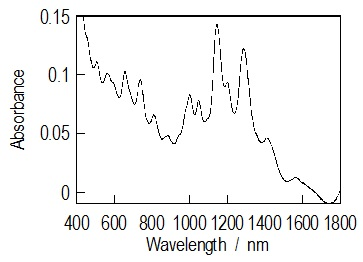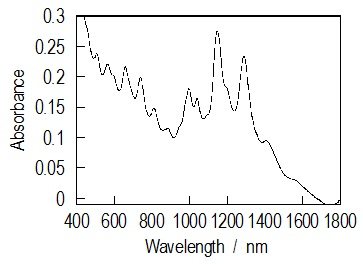Maximum quantity allowed is 999
Please select the quantity
CAS RN: 1296211-78-3 | Product Number: E1127
4,4'-[1,2-Ethenediylbis(4,1-phenyleneiminocarbonyl)]bis(N-butyl-N,N-dimethylbenzenemethanaminium) Dichloride
![4,4'-[1,2-Ethenediylbis(4,1-phenyleneiminocarbonyl)]bis(N-butyl-N,N-dimethylbenzenemethanaminium) Dichloride No-Image](/medias/E1127.jpg?context=bWFzdGVyfHJvb3R8MzQ1MzJ8aW1hZ2UvanBlZ3xhRFl3TDJnMk1DODRPVEl4TmpJek5EazBOamcyTDBVeE1USTNMbXB3Wnd8ZGY1MjQ0ODE3YjM5MTg3MTRiNTVjYjUyZDM0OGY5ODUzMGFjMzYzNWQxNTE4Y2FmYmIxOTNhNDkyNTFhNmExOA)
Purity: >94.0%(T)
Synonyms:
Product Documents:
| Size | Unit Price | Same Day | 2-3 Business Days | Other Lead Time |
Shipping Information

|
|---|---|---|---|---|---|
| 1G |
NT$6,480
|
11 | 25 | Contact Us |
* The above prices include freight cost, customs, and other charges to the destination except for products that need to be shipped by sea or dry ice. For details, please contact
our distributor
in Taiwan to order our product.
* The storage conditions are subject to change without notice.
| Product Number | E1127 |
| Purity / Analysis Method | >94.0%(T) |
| Molecular Formula / Molecular Weight | C__4__2H__5__4Cl__2N__4O__2 = 717.82 |
| Physical State (20 deg.C) | Solid |
| Storage Temperature | Room Temperature (Recommended in a cool and dark place, <15°C) |
| Condition to Avoid | Light Sensitive |
| Packaging and Container | 1G-Glass Bottle with Plastic Insert (View image) |
| CAS RN | 1296211-78-3 |
| Reaxys Registry Number | 22634941 |
| PubChem Substance ID | 354333621 |
Specifications
| Appearance | White to Yellow to Green powder to crystal |
| Purity(Nonaqueous Titration) | min. 94.0 % |
Properties (reference)
GHS
| Pictogram |

|
| Signal Word | Warning |
| Hazard Statements | H315 : Causes skin irritation. H319 : Causes serious eye irritation. |
| Precautionary Statements | P264 : Wash skin thoroughly after handling. P280 : Wear protective gloves/ eye protection/ face protection. P302 + P352 : IF ON SKIN: Wash with plenty of water. P337 + P313 : If eye irritation persists: Get medical advice/ attention. P305 + P351 + P338 : IF IN EYES: Rinse cautiously with water for several minutes. Remove contact lenses, if present and easy to do. Continue rinsing. P362 + P364 : Take off contaminated clothing and wash it before reuse. P332 + P313 : If skin irritation occurs: Get medical advice/ attention. |
Related Laws:
Transport Information:
| H.S.code* | 2924.29-000 |
Application
Single-Walled Carbon Nanotube (SWCNT) Dispersant
E1127 has strong interaction to the surface of single-walled carbon nanotube (SWCNT), and the positive charge on the stilbene core enables SWCNT to disperse in aqueous solution. UV irradiation makes closure of the stilbene moiety and elimination from the SWCNT surface which enables SWCNT to aggregate. After the aggregation, the dispersant can be easily removed by filtration, etc.
(1) Preparation of dispersions (Low power sonication)
3.6 mg of E1127 was dissolved in 3 mL of pure water (18.8 MΩ·cm, TOC < 3 ppb) or D2O using a glass vial (ca. 0.12 wt%). The solution was then sonicated (80 W, 35 kHz) at room temperature. Heating by a dryer is also a useful method for solvation. 1.96 mg of SWCNTs was added into the solution of E1127. The E1127/SWCNT mixture was sonicated (80 W, 35 kHz, 1 h) at room temperature. The black-colored dispersion was then centrifuged to remove impurities such as amorphous carbons and metal particles (28500 x g, at 22 °C, 3 hrs). Upper 70 % of supernatant was corrected as a well-dispersed SWCNT dispersion.
3.6 mg of E1127 was dissolved in 3 mL of pure water (18.8 MΩ·cm, TOC < 3 ppb) or D2O using a glass vial (ca. 0.12 wt%). The solution was then sonicated (80 W, 35 kHz) at room temperature. Heating by a dryer is also a useful method for solvation. 1.96 mg of SWCNTs was added into the solution of E1127. The E1127/SWCNT mixture was sonicated (80 W, 35 kHz, 1 h) at room temperature. The black-colored dispersion was then centrifuged to remove impurities such as amorphous carbons and metal particles (28500 x g, at 22 °C, 3 hrs). Upper 70 % of supernatant was corrected as a well-dispersed SWCNT dispersion.

(2) Preparation of dispersions (High power sonication)
10 mg of E1127 was dissolved in 20 mL of pure water (18.8 MΩ·cm, TOC < 3 ppb) or D2O using a glass vial (ca. 0.05 wt%). The solution was then sonicated (80 W, 35 kHz) at room temperature. Heating by a dryer is also a useful method for solvation. 7.0 mg of SWCNTs was added into the solution of E1127. The mixture was sonicated (80 W, 35 kHz, 1 h) at room temperature. Subsequently, the dispersion was subjected ultrasonication (60 W, 19 kHz, 4 hrs) at room temperature. The black-colored dispersion was then centrifuged to remove impurities such as amorphous carbons and metal particles (28500 x g, at 22 °C, 3 hrs). Upper 70 % of supernatant was corrected as a well-dispersed SWCNT dispersion.
10 mg of E1127 was dissolved in 20 mL of pure water (18.8 MΩ·cm, TOC < 3 ppb) or D2O using a glass vial (ca. 0.05 wt%). The solution was then sonicated (80 W, 35 kHz) at room temperature. Heating by a dryer is also a useful method for solvation. 7.0 mg of SWCNTs was added into the solution of E1127. The mixture was sonicated (80 W, 35 kHz, 1 h) at room temperature. Subsequently, the dispersion was subjected ultrasonication (60 W, 19 kHz, 4 hrs) at room temperature. The black-colored dispersion was then centrifuged to remove impurities such as amorphous carbons and metal particles (28500 x g, at 22 °C, 3 hrs). Upper 70 % of supernatant was corrected as a well-dispersed SWCNT dispersion.

(3) Photoirradiation and precipitation
A well-dispersed SWCNT dispersion was transferred to a dialysis tube (cutoff MW of 1000) to remove excess amount of E1127 from the dispersion. The tube filled with the dispersion of E1127/SWCNT system was put into a glass beaker with 3 L of pure water (18.8 MΩ·cm, TOC < 3 ppb) and was stirred overnight. The dialyzed dispersion was transferred into quartz cells and irradiated by an LED light source (365 nm, 100 mW/cm2) for several hours under magnetically stirring. After 3 hrs of light irradiation, precipitation of SWCNTs was completed for the dispersion treated with low power sonication. The SWCNT dispersion prepared using high power sonication took 7 hrs to recognize precipitation.
A well-dispersed SWCNT dispersion was transferred to a dialysis tube (cutoff MW of 1000) to remove excess amount of E1127 from the dispersion. The tube filled with the dispersion of E1127/SWCNT system was put into a glass beaker with 3 L of pure water (18.8 MΩ·cm, TOC < 3 ppb) and was stirred overnight. The dialyzed dispersion was transferred into quartz cells and irradiated by an LED light source (365 nm, 100 mW/cm2) for several hours under magnetically stirring. After 3 hrs of light irradiation, precipitation of SWCNTs was completed for the dispersion treated with low power sonication. The SWCNT dispersion prepared using high power sonication took 7 hrs to recognize precipitation.
References
- Photoinduced Dispersibility Tuning of Carbon Nanotubes by a Water-Soluble Stilbene as a Dispersant
- Effective Nondestructive Purification of Single-Walled Carbon Nanotubes Based on High-Speed Centrifugation with a Photochemically Removable Dispersant
- Y. Matsuzawa, M. Yoshida, H. Ohyama, H. Kato, Patent JP5552641.
PubMed Literature
Articles/Brochures
TCIMAIL
Product Documents (Note: Some products will not have analytical charts available.)
Safety Data Sheet (SDS)
Please select Language.
The requested SDS is not available.
Please Contact Us for more information.
Specifications
C of A & Other Certificates
Please enter Lot Number
Incorrect Lot Number. Please input only the 4-5 alphanumeric characters before the hyphen.
Sample C of A
This is a sample C of A and may not represent a recently manufactured lot of the product.
A sample C of A for this product is not available at this time.
Analytical Charts
Please enter Lot Number
Incorrect Lot Number. Please input only the 4-5 alphanumeric characters before the hyphen.
The requested analytical chart is not available. Sorry for the inconvenience.

![4,4'-[1,2-Ethenediylbis(4,1-phenyleneiminocarbonyl)]bis(N-butyl-N,N-dimethylbenzenemethanaminium) Dichloride 4,4'-[1,2-Ethenediylbis(4,1-phenyleneiminocarbonyl)]bis(N-butyl-N,N-dimethylbenzenemethanaminium) Dichloride](/_ui/responsive/theme-tci/images/missing_product_zoom.jpg)

